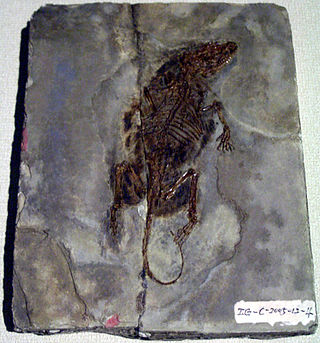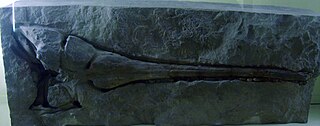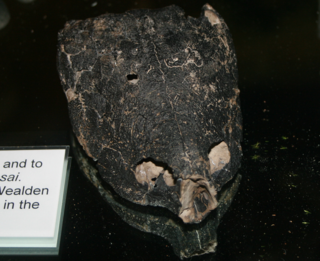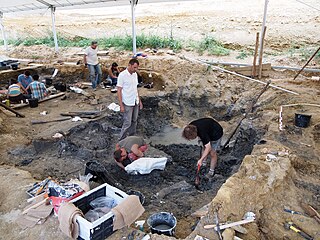
Sunnyodon is a genus of tiny, extinct mammal, probably of the Lower Cretaceous. Found in what is now southern England and Denmark, it was a relatively early member of the extinct order of Multituberculata. It is part of the suborder Plagiaulacida and family Paulchoffatiidae.

Echinodon is a genus of heterodontosaurid dinosaur that lived during the earliest Cretaceous of southern England and possibly western France in the Berriasian epoch. The first specimens were jaw bones named Echinodon becklesii by Sir Richard Owen in 1861, and since their original description only additional teeth have been discovered. The specific name honours collector Samuel Beckles who discovered the material of Echinodon and many other taxa from across England, while the genus name translates as "prickly tooth" in reference to the dental anatomy of the taxon.

Goniopholis is an extinct genus of goniopholidid crocodyliform that lived in Europe and North America during the Late Jurassic and Early Cretaceous. Like other goniopholidids, it resembled living crocodilians, and probably had a similar ecology as semi-aquatic ambush predators.

Symmetrodonta is a group of Mesozoic mammals and mammal-like synapsids characterized by the triangular aspect of the molars when viewed from above, and the absence of a well-developed talonid. The traditional group of 'symmetrodonts' ranges in age from the latest Triassic to the Late Cretaceous, but most research in the last 20-30 years has concluded that they are not a true taxonomic group, but include several unrelated branches of the mammal tree. Despite this, the name is still used informally by some researchers for convenience, usually restricted to the spalacotheriids and zhangheotheriids.

Nuthetes is the name given to a genus of coelurosaurian theropod dinosaur, either a dromaeosaurid or a tyrannosauroid, known only from fossil teeth and jaw fragments found in rocks of the middle Berriasian age in the Cherty Freshwater Member of the Lulworth Formation in England and also the Angeac-Charente bonebed in France. If it was a dromaeosaurid, Nuthetes would have been a small predator.

Volaticotherini is a clade of eutriconodont mammals from the Mesozoic. In addition to the type genus Volaticotherium, it includes the genera Argentoconodon, Ichthyoconodon, and potentially Triconolestes.

Turiasauria is an unranked clade of basal sauropod dinosaurs known from Middle Jurassic to Early Cretaceous deposits in Europe, North America, and Africa.

Cladotheria is a clade of mammals. It contains modern therian mammals and several extinct groups, such as the "dryolestoids", amphitheriids and peramurids. The clade was named in 1975 by Malcolm McKenna. In 2002, it was defined as a node-based taxon containing "the common ancestor of dryolestids and living therians, plus all its descendants". A different, stem-based definition was given in 2013, in which Cladotheria contains all taxa that are closer to Mus musculus than to the "symmetrodont" Spalacotherium tricuspidens.

The Albanerpetontidae are an extinct family of small amphibians, native to the Northern Hemisphere during the Mesozoic and Cenozoic. The only members of the order Allocaudata, they are thought to be allied with living amphibians belonging to Lissamphibia. Despite a superficially salamander-like bodyform, their anatomy is strongly divergent from modern amphibians in numerous aspects. The fossil record of albanerpetontids spans over 160 million years from the Middle Jurassic to the beginning of the Pleistocene, about 2.13–2 million years ago.

Owenodon is a genus of iguanodontian dinosaur known from a partial lower jaw discovered in Early Cretaceous-age rocks of Dorset, United Kingdom, and possibly also Romania and Spain. The first and only definitive specimen was found in the Lulworth Formation of the Purbeck Limestone Group, dating to the middle Berriasian stage. It was first described by Richard Owen as a species Iguanodon, I. hoggii, honouring naturalist A.J. Hogg who had originally collected the fossil. Owen described the mandible as it was, partially embedded in a limestone block, but it was given to the Natural History Museum, London where it was accessioned as NHMUK PV R 2998 and further prepared. Some damage occurred to a tooth crown and part of the bone while stored in the collections. Redescription of I. hoggii by David Norman and Paul Barrett subsequently transferred the species to Camptosaurus in 2002, as well as tentatively referring other camptosaur-like material from the Purbeck beds to the species. The identity of the species was questioned, with Kenneth Carpenter and Yvonne Wilson, and Greg Paul, separating "C." hoggi from Camptosaurus as an intermediate ornithopod, until Peter Galton named the new genus Owenodon for it in 2009. Galton removed the material assigned by Norman and Barrett from Owenodon, but referred isolated teeth from the Bauxite of Cornet, Romania, and the El Castellar Formation of Spain to O. hoggii. The taxon, believed by Galton to be intermediate between Camptosaurus and Iguanodon, is of uncertain relationships, with the limited material preventing clear understanding of its position within ornithopod evolution. Phylogenetic studies have found Owenodon to be more primitive, equivalent to, or more derived than Camptosaurus, but it is often excluded to improve results.

Pholidosaurus is an extinct genus of neosuchian crocodylomorph. It is the type genus of the family Pholidosauridae. Fossils have been found in northwestern Germany. The genus is known to have existed during the Berriasian-Albian stages of the Early Cretaceous. Fossil material found from the Annero and Jydegård Formations in Skåne, Sweden and on the island of Bornholm, Denmark, have been referred to as a mesoeucrocodylian, and possibly represent the genus Pholidosaurus.

Pleurosternon is an extinct genus of freshwater pleurosternid turtle from the latest Jurassic to earliest Cretaceous of Europe. Its type species, P. bullockii was described by the paleontologist Richard Owen in 1853. Since then, and throughout the late 19th century, many fossil turtles were incorrectly assigned to this genus, though only two are currently considered valid.

The Helochelydridae are an extinct family of stem-turtles known from fossils found in North America and Europe spanning the Early to Late Cretaceous.
Jugulator is an extinct genus of mammals from the Cretaceous of North America. It contains one species, Jugulator amplissimus. A eutriconodont, it is known from the Cedar Mountain Formation, and is both a large sized and possibly ecologically specialised taxon, showcasing the diversity of mammals in the Mesozoic.

Triconodon is a genus of extinct mammal from the Early Cretaceous of England and France with two known species: T. mordax and T. averianovi. First described in 1859 by Richard Owen, it is the type genus for the order Triconodonta, a group of mammals characterised by their three-cusped (triconodont) molar teeth. Since then, this "simplistic" type of dentition has been understood to be either ancestral for mammals or else to have evolved multiple times, rendering "triconodonts" a paraphyletic or polyphyletic assemblage respectively, but several lineages of "triconodont" mammals do form a natural, monophyletic group, known as Eutriconodonta, of which Triconodon is indeed part of.

Peramus is an extinct genus of cladotherian mammal. It lived in the Late Jurassic and Early Cretaceous of Europe and North Africa.
Achyrodon is an extinct genus of mammal from the Berriasian epoch of Early Cretaceous southern England. The taxon was first described by Richard Owen in 1871 for teeth from the Lulworth Formation. The taxon has been considered a synonym of co-existing Amblotherium pusillum, but can be distinguished by differences in the dental anatomy and an overall smaller size. Achyrodon was closely related to co-existing genus Phascolestes and the slightly younger European form Crusafontia, and together they make up the subfamily Kurtodontinae within Dryolestidae, a family of early mammals between modern monotremes and therians with no living descendants.

Phascolestes is a genus of extinct mammal from the Berriasian epoch of Early Cretaceous Southern England. The type and only species is Phascolestes mustelulus, which was named by Richard Owen in 1871 for dental material from the Lulworth Formation. Phascolestes is a close relative of co-existing taxon Achyrodon within the subfamily Kurtodontinae of the family Dryolestidae, with Kurtodon being a junior synonym of Phascolestes although the subfamily name is still applicable.
Thereuodon is a genus of extinct mammal known from the Early Cretaceous of southern England, Morocco and France. The type species, named by Denise Sigogneau-Russell in 1989 for teeth from the earliest Cretaceous Ksar Metlili Formation of Morocco, is Thereuodon dahmani, while the referred species named by Sigogneau-Russell and Paul Ensom for teeth from the Lulworth Formation of England is Thereuodon taraktes. The two species are separated by a break in the cingulum in T. dahmani, a more obtuse medial crest in T. taraktes, a duller stylocone in T. taraktes, a "c" cuspule in T. dahmani, and a reduced facet A in T. taraktes. The genus Thereuodon is the only taxon in the symmetrodont family Thereuodontidae, which may be closely related to Spalacotheriidae. A tooth referred to T. cf. taraktes is known from the Berriasian aged Angeac-Charente bonebed of France.

The Angeac-Charentebonebed is a fossil deposit located near Angeac-Charente in western France. It dates to the Berriasian stage of the Early Cretaceous, and is coeval with the Purbeck Group of Southern England. It has amongst the most diverse assemblages of earliest Cretaceous vertebrates known from Europe.





















